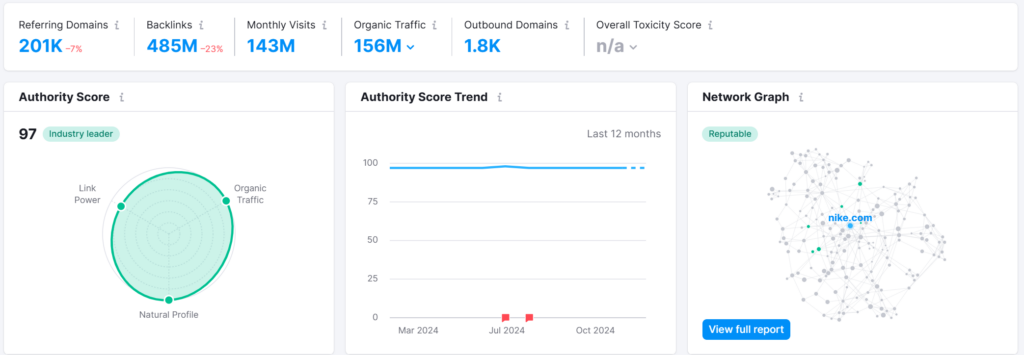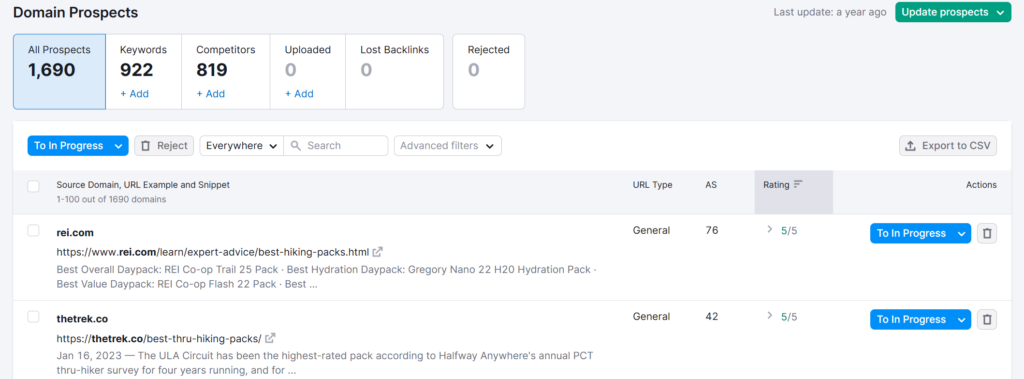Start your websites journey to the top today! Our complete website audit provides you with the information you need. This will help you improve your performance and rank on the search results page.
– Performance Report
– Backlink Overview
– On-Page SEO Audit

Referring domains play a pivotal role in SEO, shaping how search engines view and rank your website. But what exactly are they, and why do they matter?
In simple terms, referring domains are unique websites that link back to yours. Each of these links acts as a signal of trust and authority, which search engines like Google consider when determining your site’s credibility and visibility.
So, why is this important?
The quantity and quality of your referring domains can significantly impact your SEO performance. Strong, relevant links from reputable sites can boost your rankings and help drive organic traffic.
This guide will simplify the concept of referring domains and provide actionable tips to help you attract high-quality links. Whether you’re a business owner, marketing professional, or web developer, you’ll find strategies here to enhance your website’s authority and search engine visibility.
Ready to learn how to build a stronger link profile? Let’s get started.

To grasp the importance of referring domains, let’s first dissect the concept. A referring domain is any website that directs traffic to your site through a hyperlink. Each website hosting a link is counted once, regardless of the number of backlinks it provides.
Identifying these domains is vital because they function as endorsements of your site’s content. When high-quality domains link to you, it signals search engines that your content holds value. Consequently, this can enhance your rankings.
Referring domains aren’t to be confused with mere backlinks. While a single domain can provide multiple backlinks, what truly boosts authority is the number of unique referring domains.
In SEO, quality trumps quantity. A few strong referring domains can do more for your SEO than numerous low-quality ones. This is because search engines prioritize links from authoritative and trustworthy sites.
Therefore, focusing on strategies to grow your list of referring domains can significantly impact your site’s authority. Below are key reasons why expanding your referring domains is crucial:
By now, you should grasp why referring domains are a cornerstone of any robust SEO strategy. Let’s delve deeper into the intricacies of what they are.

Incorporating local keyword research into your SEO strategy can significantly boost your business’s online presence. When potential customers search for products or services nearby, they often have high intent to purchase. By targeting these specific keywords, you can attract more qualified leads.
Effective local keyword research ensures that your business appears in local search results. This visibility can increase foot traffic and enhance your brand’s credibility within your community. With the right keywords, you’re not just reaching more people, but the right people.
Additionally, local keyword research allows you to compete more effectively against local and larger businesses. By focusing on niche terms specific to your area, you can carve out a space in competitive markets. This approach not only helps in gaining more customers but also strengthens local community ties, making your brand a trusted name in your area.
Referring domains are the bedrock of effective link building. Each unique domain providing a link to your website adds to your tally of referring domains.
Notably, a single domain may link multiple times. However, it’s the diversity of domains that adds real value to your SEO. Having links from various unique domains greatly enhances the trustworthiness of your site in the eyes of search engines.
This is because search engines like Google treat each domain as a separate endorsement. A website with numerous endorsements is seen as more credible, often leading to higher rankings.
Referring domains play a pivotal role in how search engines evaluate your site’s authority. More referring domains generally indicate a wider acceptance and credibility of your content.
The correlation between referring domains and search rankings is strong. Websites with many high-quality referring domains are often seen as authorities in their field. This boosts their position in search engine results.
Moreover, referring domains contribute to increased traffic. Links from varied domains can drive diverse audiences to your site, expanding your reach. They also help in building relationships with other businesses and influencers in your niche, which can lead to more collaborative opportunities.
Incorporating strategies to increase referring domains should be an integral part of your SEO blueprint. It sets a foundation for sustained traffic and higher rankings.

Understanding the distinction between referring domains and backlinks is crucial. Many people use these terms interchangeably, but they have different meanings. Let’s clarify these concepts.
A referring domain is essentially the website that hosts one or more links pointing to your site. It signifies the origin of the backlinks. Each unique site links to your website counts as one referring domain, regardless of how many links it includes.
Backlinks, on the other hand, are the actual links from various pages on these domains. A single domain can host multiple backlinks to your website. While backlinks contribute to your link profile, it’s the unique referring domains that bolster your site’s authority.
The value lies in the diversity and quality of referring domains. Having numerous backlinks from a single domain does not have the same impact as having links from multiple high-quality domains. Search engines view diverse referring domains as a testament to your site’s value and relevance.
Here are key differences between referring domains and backlinks:
In building a robust SEO strategy, aim for a mix of diverse referring domains and quality backlinks. While backlinks help, referring domains add authority by showcasing that multiple sources recognize the value of your content. This recognition plays a significant role in enhancing search engine trust and, subsequently, rankings.
Finding the right referring domains can accelerate your SEO efforts. But where do you start? Identifying those with high authority and relevance is key.
Begin by analyzing the profiles of your competitors. This insight helps uncover valuable referring domains that already link to them. Understanding where their links come from can reveal opportunities for your site.
SEO tools play a significant role in discovery. These tools can reveal domains relevant to your niche and assess their quality. Utilizing SEO tools will streamline your process and enhance targeting efforts.
Diversifying your domain sources is beneficial. Aim for different types of domains, such as educational (.edu) or governmental (.gov), which are highly regarded by search engines. Exploring a range of sources ensures a well-rounded link profile.
Competitor analysis is a powerful tactic to identify potential referring domains. Start by reviewing competitors who rank well in search results. Tools like SEMrush or Ahrefs allow you to view their backlink profiles.
Examine the domains that link to your competitors and assess their relevance. These insights can guide your outreach strategies by targeting domains with a known interest in your industry. By leveraging competitor data, you can form a strategy that reflects successful trends while carving out your unique path.
SEO tools like Moz, Ahrefs, and SEMrush provide comprehensive insights into potential referring domains. They offer metrics to evaluate the authority and relevance of domains you might target.
Such tools simplify the identification process by highlighting domains that align with your niche and boast high authority. Additionally, they enable efficient tracking of your progress and performance, ensuring your strategy remains focused and effective. Using these tools wisely can significantly boost your referring domains with less manual effort.

Crafting content that naturally attracts referring domains is crucial. Quality content invites links from various sources, enhancing your site’s authority.
First, aim to create content that’s both informative and engaging. This combination increases the chances of getting linked by others. It helps establish your site as a trusted resource.
Second, focus on audience needs. Understand what they value and find appealing. Tailor your content to meet these needs, ensuring it stands out in your industry.
Interactive content often garners more attention. Think quizzes, surveys, or tools that involve your audience actively. This engagement can result in more shares and links.
Timely content also attracts links. Publishing articles or posts about current trends or news relevant to your niche can capture traffic and interest. People will more likely reference timely, insightful content.
Encouraging contributions from industry experts elevates content quality. Collaborations can introduce your site to new audiences, increasing the potential for obtaining new links. This method broadens your site’s reach within and beyond your niche.
High-quality, shareable content is a magnet for links. It sparks interest, urging others to link back as a reference. Aim to be original and comprehensive to stand out.
Original content provides new perspectives and solutions, making it link-worthy. Avoid regurgitating what’s already out there. Instead, offer unique insights based on thorough research or personal expertise.
Comprehensive guides are particularly valuable. They cover topics in-depth, making them useful resources for readers. As these guides become reference points, they’re more likely to receive links.
Remember to make your content easily shareable. Incorporate user-friendly sharing buttons and calls to action. Doing so encourages spreading your work across various platforms, increasing its visibility.
Visual content is powerful in attracting links. Infographics, images, and videos make information digestible and appealing. They’re often shared, bringing your site more attention and referrals.
Infographics are particularly effective. They present complex data simply, making it more likely to be cited by other websites. A well-crafted infographic can quickly become a valuable resource across industries.
Beyond infographics, videos also play a significant role. Engaging, informative videos catch attention and encourage sharing. Consider hosting tutorials or explainer videos related to your niche.
Ensure your visual content is of high quality. This means employing appealing designs, clear narratives, and concise messaging. Such professionalism boosts the likelihood of earning backlinks.
Embed codes for infographics or videos make sharing easier. Providing these codes encourages other site owners to share content while linking back to your site. This simple action can exponentially boost your referring domains.

Effective outreach is a cornerstone of successful link building. It connects your content with authoritative websites, increasing your referring domains. The key is building genuine relationships with site owners.
Start by researching sites related to your niche that could benefit from your content. List those with high engagement and domain authority. Tailored outreach to these sites can significantly boost your link profile.
Personalize your outreach emails or messages. Use the recipient’s name and reference their work. This personal touch demonstrates your genuine interest and increases your chances of a positive response.
Offer mutual value in your outreach. Highlight how your content will benefit their audience or fill a content gap. This collaborative approach encourages partnerships and link exchanges.
Consistently follow up on your initial outreach. Persistence without being pushy is essential. A well-timed reminder can often convert a tentative “maybe” into a “yes.”
Guest blogging remains a powerful tool for link building. It involves writing articles for other sites within your niche. This practice increases your exposure and credibility.
Choose sites that align with your niche’s values and audience. This ensures that your content resonates and increases your chance of being published. Each published post typically includes a link back to your site, boosting your referring domains.
Content collaboration goes beyond guest blogging. Partner with other industry experts to co-author content or conduct interviews. These collaborations broaden your reach and solidify authoritative relationships.
Guest blogging remains a powerful tool for link building. It involves writing articles for other sites within your niche. This practice increases your exposure and credibility.
Choose sites that align with your niche’s values and audience. This ensures that your content resonates and increases your chance of being published. Each published post typically includes a link back to your site, boosting your referring domains.
Content collaboration goes beyond guest blogging. Partner with other industry experts to co-author content or conduct interviews. These collaborations broaden your reach and solidify authoritative relationships.

Keeping track of your referring domains is vital for sustained SEO success. It allows you to understand the quality and quantity of the backlinks pointing to your site. This insight aids in maintaining a healthy link profile.
Regular monitoring helps identify any sudden changes in backlinks. These changes could signal potential SEO threats, like negative SEO tactics. Being proactive can mitigate any adverse effects on your site’s ranking.
Effective maintenance involves checking the diversity of your referring domains. A varied profile enhances your site’s credibility and reduces the risk of over-reliance on a single domain. Ensuring diversity keeps your SEO efforts robust and resilient.
Engaging with tools that offer comprehensive data on referring domains is beneficial. Tools such as Ahrefs or SEMrush provide detailed reports. These insights help refine your SEO strategy and capitalize on new opportunities.
Conducting a backlink audit is a crucial part of maintaining your referring domain profile. It involves assessing all the links pointing to your website. This process helps identify toxic backlinks that might harm your SEO.
Begin by utilizing SEO tools to compile a list of all current backlinks. Analyze these links to spot patterns or irregularities. Identifying harmful links allows you to disavow them, protecting your site’s reputation.
Employing analytics tools is essential for tracking referring domains and backlinks. Google Analytics and Google Search Console are reliable platforms. They offer insights into which domains are linking to your website.
Regularly check the reports available in these tools. Look for any shifts in referring domains or backlink volumes. This data can inform strategies to strengthen your link profile and improve site authority.
Employing analytics tools is essential for tracking referring domains and backlinks. Google Analytics and Google Search Console are reliable platforms. They offer insights into which domains are linking to your website.
Regularly check the reports available in these tools. Look for any shifts in referring domains or backlink volumes. This data can inform strategies to strengthen your link profile and improve site authority.
Incorporating strategies to boost referring domains is a worthwhile endeavor in enhancing your SEO performance. Focusing on high-quality content and leveraging proven link building techniques fortifies your site’s authority. Cultivating diverse referring domains ensures long-term growth and resilience.
Begin by conducting a thorough analysis of your current backlink profile. Implement a structured approach to identify potential domains and pursue strategies for fruitful engagements. Stay vigilant, monitoring your referring domain profile consistently. This proactive stance enables ongoing optimization and adaptation to SEO trends. Embrace these steps, and watch your site flourish in visibility and ranking.